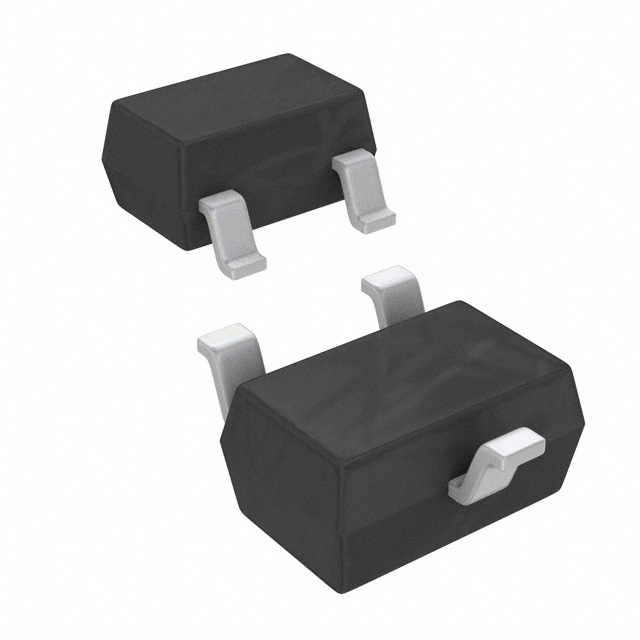Viz Specifikace pro podrobnosti o produktu.

MMBZ5246BW-7
Introduction
The MMBZ5246BW-7 is a semiconductor product belonging to the category of Zener diodes. This entry provides an overview of the basic information, specifications, pin configuration, functional features, advantages and disadvantages, working principles, application field plans, and alternative models of the MMBZ5246BW-7.
Basic Information Overview
- Category: Zener Diode
- Use: Voltage regulation and protection in electronic circuits
- Characteristics: Precise voltage regulation, low leakage current, small package size
- Package: SOT-323, SMD (Surface Mount Device)
- Essence: Semiconductor device for maintaining a stable voltage across a load
- Packaging/Quantity: Typically available in reels of 3000 units
Specifications
- Voltage - Zener (Nom) (Vz): 16V
- Power - Max: 350mW
- Impedance (Max) (Zzt): 20 Ohm
- Current - Reverse Leakage @ Vr: 100nA
- Operating Temperature: -65°C to 150°C
- Mounting Type: Surface Mount
- Package / Case: SC-70, SOT-323
Detailed Pin Configuration
The MMBZ5246BW-7 typically has three pins: Cathode, Anode, and No Connection (NC). The pinout configuration is as follows: - Cathode (K): Connected to the ground or reference potential - Anode (A): Connected to the positive terminal of the circuit - No Connection (NC): Not internally connected, left unconnected in the circuit
Functional Features
- Voltage Regulation: Maintains a constant voltage across the load
- Overvoltage Protection: Safeguards sensitive components by limiting the voltage
- Stable Operation: Provides stable voltage under varying load conditions
Advantages and Disadvantages
Advantages
- Precise voltage regulation
- Small package size
- Low leakage current
Disadvantages
- Limited power dissipation capability
- Susceptible to damage from overcurrent conditions
Working Principles
The MMBZ5246BW-7 operates based on the principle of the Zener effect, where it maintains a nearly constant voltage across its terminals when reverse-biased. It achieves this by allowing a controlled amount of current to flow in the reverse direction, effectively regulating the voltage.
Detailed Application Field Plans
The MMBZ5246BW-7 finds applications in various electronic circuits, including: - Voltage regulation in power supplies - Overvoltage protection in communication systems - Signal clamping in audio amplifiers
Detailed and Complete Alternative Models
Some alternative models to the MMBZ5246BW-7 include: - BZX84C16LT1G - MM3Z16VT1G - MMSZ5246BT1G
In conclusion, the MMBZ5246BW-7 Zener diode offers precise voltage regulation and overvoltage protection in a compact SMD package, making it suitable for a wide range of electronic applications.
[Word Count: 411]
Seznam 10 běžných otázek a odpovědí souvisejících s aplikací MMBZ5246BW-7 v technických řešeních
What is the MMBZ5246BW-7?
- The MMBZ5246BW-7 is a Zener diode with a voltage of 16V and a power dissipation of 200mW.
What are the typical applications of MMBZ5246BW-7?
- It is commonly used in voltage regulation, overvoltage protection, and signal clamping applications.
What is the maximum current that MMBZ5246BW-7 can handle?
- The maximum current for MMBZ5246BW-7 is 5mA.
Can MMBZ5246BW-7 be used for ESD protection?
- Yes, it can be used for Electrostatic Discharge (ESD) protection due to its Zener diode characteristics.
What is the temperature range for MMBZ5246BW-7?
- The operating temperature range is -55°C to +150°C.
Is MMBZ5246BW-7 RoHS compliant?
- Yes, it is RoHS compliant, making it suitable for environmentally friendly designs.
How does MMBZ5246BW-7 compare to other Zener diodes in terms of performance?
- MMBZ5246BW-7 offers stable and precise voltage regulation with low leakage current and excellent thermal stability.
Can MMBZ5246BW-7 be used in automotive applications?
- Yes, it is suitable for automotive applications where reliable voltage regulation and overvoltage protection are required.
What is the package type for MMBZ5246BW-7?
- It comes in a SOT-23 surface mount package, which is compact and suitable for space-constrained designs.
Are there any specific layout considerations when using MMBZ5246BW-7 in a circuit?
- It is recommended to minimize trace lengths and keep the Zener diode close to the components it is protecting to ensure optimal performance.
Feel free to ask if you need further information on any of these questions!

